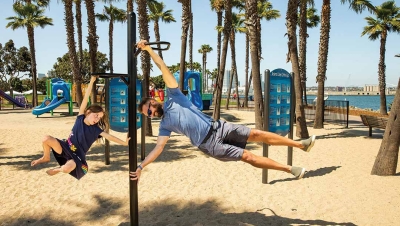An ounce of prevention is worth its weight in gold when it comes to obesity issues
There’s no fun in exercise. If you believe that, you haven’t been on a playground lately. They just don’t make them like they used to…and that is one of the great things about them. The trouble is that with all the video games out today, kids have more incentive to stay indoors and hang out rather than get out and get moving. That doesn’t mean video games have no value…hand-eye coordination definitely benefits from them. It’s just that you don’t have to move around to play them.
With more and more pressure on academics, it seems that the physical part of learning has taken a bit of a back seat. That’s not to say the schools just don’t care. Our children even take health classes, but without some practical application, they won’t see as much benefit from them.
Schools are trying more and more to find that happy medium where the children get the physical activity they need and still have all the time they need for academic excellence. Talk to an educator and they’ll likely tell you that children who have the chance to get out and climb around a playground and clear their minds for a bit come back refreshed and ready to learn again when it’s time to get back to work, and their academic skills improve that much more.
Children need that physical exercise for intellectual stimulation but also for health reasons. Childhood obesity seems to have reached epidemic proportions in our society. We don’t even have to consult data to notice it. It’s all around us. We live in a “work smarter instead of harder and eat fast food” age, which seems predictable to a certain degree because technology and society are changing at a rapid rate. However, we seem to be forgetting the importance of physical activity as we streamline our daily activities so we can get everything done. Exercise is still a basic component of healthy development and still goes hand in hand with good nutrition. (Check out the USDA Healthy Food Pyramid at http://www.usda.gov/cnpp/KidsPyra/ if you need a refresher on a healthy diet).
The being “fat” part of obesity isn’t the only problem with it. In addition to the ridicule, children endure because of their outward appearance, it tends to lead to other health problems such as diabetes. Juvenile diabetes is also on the rise as a result of obesity issues. More and more you see kids packing a “kit,” as one child calls it. That would be his insulin supply he can’t do without as he goes about his daily activities.
It’s hard to say exactly how he ended up in this scenario because there could be other things such as genetics at work, but it could be largely due to lack of physical exercise. This child is an absolute whiz at video games. Video games don’t have to be completely cut out of a child’s life for him to be healthy, but it is recommended that they have at least 30 minutes a day of physical activity (just as for adults), meaning that a limit on the sedentary activities would help. Can you see the need to get kids moving again?
How in the world do we accomplish this? We can’t all take our children to the gym to work out. Frankly, their little muscles aren’t ready for the rigorous exercise programs adults participate in any way, and not all kids have the opportunity to participate in team sports. One thing that can help is the playground. Combine that with good nutritional habits and you have a vital part of their health and a good preventative measure to help combat obesity.
If you’ve tried to get children to exercise, you may have been met with excuses including, “It’s too boring.” Why do they feel the need to get out of exercise? It’s simple…they associate it with work and may not realize it can be fun. That goes back to that whole “work smarter not harder” thing to a degree. They need to be able to exercise without even knowing they are exercising. How do you accomplish this? There are a number of great new playground systems out there now that can get the job done without making it feel like work.
To respond to the need for schools to increase fitness levels associated with the President’s Council on Physical Fitness, BCI-Burke created Circuit Play. It was designed to be fun while increasing fitness. With this system, there is no getting across the playground without finding some fun in the middle. In fact, it runs circles around the idea that there is no fun in exercise. “When testing Circuit Play, the kids knew right away how to play on it,” says Cheryl Van Den Bogart, Marketing Director of BCI-Burke “and they were playing without realizing they were really exercising.”
You can choose from a large variety of ground-level play and fitness pieces designed to be challenging, increase balance and climbing ability while still being stimulating. How fun would it be for your kids to play the “don’t touch the ground” game as they exercise or see how many times they can go around, all the while increasing their fitness?
Circuit Play components are easily installed in a circle similar to circuit training areas you will find in the gym. Each piece of the equipment has its value and works different parts of the body. Kids who play on it are getting a real workout. For more information, visit http://www.bciburke.com/circuit_play.iml. This system was launched in June of 2004 and can either be the next step in additions to your playground system or even a stand-alone play structure. Circuit Play is a great way to combine fun with the challenge you would find at an obstacle course and at the same time build strength, stamina and increase self-esteem.
GameTime also has the right idea for obesity prevention on the playground while children combine fun and fitness. To address the obesity issue, they commissioned Dr. Lou Bowers – Professor Emeritus of the University of South Florida, to complete a study to find out what benefit play has on overall fitness for children.
They used devices to measure caloric burn at rest and then compared them to readings after playing. They found that most children fell into the minimum benefit zone of the surgeon general standards of fitness and that it could help for them to burn an extra 85 calories a day. So, in response to the need to reduce children’s health risks, they came up with the system called the FitKid program.
There is an actual curriculum guide designed to accompany FitKid fitness structures. It includes basic, intermediate and advanced activities for each component, which help with overall fitness and motor skills and also promote creativity. It challenges the kids and also lets them exercise creativity. “Kids think of it as fun and not as having to work or exercise,” says Anne-Marie Spencer, Marketing Communications Manager for GameTime.
It is an easily-installed system since the components are largely stand-alone, and there aren’t a lot of pieces to bolt together. It is something that can be added to your existing playground structure or purchased as a stand-alone system itself. This system is a great way to get kids moving, teach them about fitness with the curriculum, and help them prevent obesity without even realizing they are doing so.
With the progress we have made in today’s playground equipment, fitness can be brought back into the picture to help overcome the obstacles of childhood obesity. Obesity is an issue that does warrant addressing in childhood years to promote a healthy lifestyle for the adult years also. Be sure to take a look at these new systems for your school or city playground and incorporate a healthy diet into your routine. Before you know it, you will have added fun to fitness while helping prevent the trials of obesity.














Add new comment